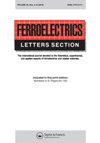Structural and photoluminescence properties of a trivalent rare earth Sm ion-doped PVA/PVP blend polymer films
IF 1.2
4区 物理与天体物理
Q4 PHYSICS, CONDENSED MATTER
引用次数: 1
Abstract
Abstract Transparent polyvinyl alcohol (PVA)/polyvinylpyrrolidone (PVP) and various concentrations of Sm3+ ion-doped PVA/PVP blend-polymer films were prepared using the solution cast method. The structural properties were studied by using XRD and FTIR. Optical UV-Vis, photoluminescence, and decay studies were carried out for prepared PVA/PVP blend polymer films. The XRD confirms the structural change in PVA/PVP blend-polymer with the doping of Sm3+ ion. From FTIR, Sm3+ ion forms the complex formation within the PVA/PVP polymer structure. The allowed band gap decreased from 5 to 4.6 eV, and the refractive index increased from 2.4 to 2.45, increasing Sm3+ ion concentration. From the energy band gap, the bonding parameters ( and δ) were calculated to find the covalent/ionic bond nature of the prepared polymer films. The emission spectra were measured for Sm3+: PVA/PVP with the excitation of 402 nm wavelength (6H5/2→4F7/2). 4G5/2→ 6H7/2 shows maximum intensity at 0.4 wt % of Sm3+, and beyond concentration, quenching was noticed. It is observed from the decay curve that the lifetime of PVA/PVP samples doped with Sm3+ at all concentrations decreases with the increase of Sm3+ ion concentration. It was noticed from CIE chromaticity that Sm3+: PVA/PVP blend polymer films are more appropriate for enhancing reddish-orange photonic emission. Based on the above results, Sm3+: PVA/PVP blend polymer films are suitable for reddish-orange luminescent applications.三价稀土Sm离子掺杂PVA/PVP共混聚合物薄膜的结构和光致发光性能
摘要采用溶液浇铸法制备了透明聚乙烯醇(PVA)/聚乙烯吡罗烷酮(PVP)和不同浓度Sm3+离子掺杂的PVA/PVP共混聚合物薄膜。采用XRD和FTIR对其结构性能进行了研究。对制备的PVA/PVP共混聚合物薄膜进行了紫外-可见、光致发光和衰减研究。XRD证实了Sm3+离子掺杂后PVA/PVP共混聚合物的结构变化。从FTIR看,Sm3+离子在PVA/PVP聚合物结构内形成络合物。允许带隙从5 eV减小到4.6 eV,折射率从2.4增加到2.45,Sm3+离子浓度增加。从能带隙中计算成键参数(和δ),以确定聚合物薄膜的共价键/离子键性质。测量了Sm3+: PVA/PVP在402 nm激发波长(6H5/2→4F7/2)下的发射光谱。4G5/2→6H7/2在Sm3+浓度为0.4 wt %时强度最大,超过浓度后出现淬灭现象。从衰减曲线上可以看出,随着Sm3+离子浓度的增加,掺杂Sm3+的PVA/PVP样品的寿命均呈下降趋势。CIE色度分析表明,Sm3+: PVA/PVP共混聚合物薄膜更适合增强红橘色光子发射。基于以上结果,Sm3+: PVA/PVP共混聚合物薄膜适用于红橙色发光应用。
本文章由计算机程序翻译,如有差异,请以英文原文为准。
求助全文
约1分钟内获得全文
求助全文
来源期刊

Ferroelectrics Letters Section
物理-物理:凝聚态物理
CiteScore
1.10
自引率
0.00%
发文量
1
审稿时长
4.8 months
期刊介绍:
Ferroelectrics Letters is a separately published section of the international journal Ferroelectrics. Both sections publish theoretical, experimental and applied papers on ferroelectrics and related materials, including ferroelastics, ferroelectric ferromagnetics, electrooptics, piezoelectrics, pyroelectrics, nonlinear dielectrics, polymers and liquid crystals.
Ferroelectrics Letters permits the rapid publication of important, quality, short original papers on the theory, synthesis, properties and applications of ferroelectrics and related materials.
 求助内容:
求助内容: 应助结果提醒方式:
应助结果提醒方式:


